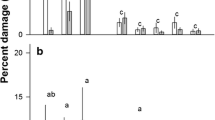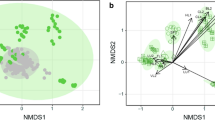Abstract
In Amazonian Peru, the neotropical tree Protium subserratum Engl. (Burseraceae) occurs as distinct ecotypes on low nutrient white-sand (WS), intermediate fertility brown-sand (BS), and nutrient-rich clay (CS) soils. Genetic analysis indicates that these ecotypes are undergoing incipient speciation. Possible drivers of this divergence are habitat-specific herbivore faunas and differing resource availabilities. Protium subserratum, therefore, provides an ideal opportunity to investigate how defense chemistry evolves during lineage divergence. WS and BS races of P. subserratum are host to largely non-overlapping herbivore communities and they differ in chlorogenic acid, flavonoid, and oxidized terpene chemistry. Here, we investigate how another important class of anti-herbivore chemicals, procyanidins (PCs), varies among the ecotypes. We isolated the PCs from leaves of juvenile and adult trees from each ecotype and used spectroscopic and chemical techniques to characterize the chemical structures of their component monomers. We found that WS, BS, and CS ecotypes accumulate ca. 17 % of leaf dry weight as PCs. Within ecotypes, we found very little difference in PC type, neither by site nor by life stage. Among ecotypes, however, we observed a marked divergence in PC composition that arose at least in part from differences in their terminal and extension subunits. In addition, the average polymer length of BS and CS PCs was significantly greater than in WS ecotypes. We conclude that phenotypic differences in PCs in the WS versus BS and CS ecotypes of P. subserratum are consistent with selection by herbivores in different soil types that differ strongly in nutrient availability and may contribute to the evolution of habitat specialization.





Similar content being viewed by others
References
Barbehenn RV, Constabel CP (2011) Tannins in plant-herbivore interactions. Phytochemistry 72:1551–1565. doi:10.1016/j.phytochem.2011.01.040
Barbehenn RV, Jones CP, Karonen M, Salminen JP (2006) Tannin composition affects the oxidative activities of tree leaves. J Chem Ecol 32:2235–2251. doi:10.1007/s10886-006-9142-8
Barone JA (2000) Comparison of herbivores and herbivory in the canopy and understory for two tropical tree species. Biotropica 32:307–317. doi:10.1111/j.1744-7429.2000.tb00474.x
Barton KE, Koricheva J (2010) The ontogeny of plant defense and herbivory: characterizing general patterns using meta-analysis. Am Nat 175:481–493. doi:10.1086/650722
Basset Y, Charles EC, Novotny V (1999) Insect herbivores on parent trees and conspecific seedlings in a rain forest in Guyana. Selbyana 20:146–158
Bates D, Maechler M, Bolker B, Walker S (2014) Ime4: Linear mixed-effects models using Eigen and S4. http://CRAN.R-project.org/package=Ime4
Boege K, Marquis RJ (2005) Facing herbivory as you grow up: the ontogeny of resistance in plants. Trends Ecol Evol 20:441–448. doi:10.1016/j.tree.2005.05.001
Chougule NP, Bonning BC (2012) Toxins for transgenic resistance to hemipteran pests. Toxins 4:405–429. doi:10.3390/toxins4060405
Coley PD, Barone JA (1996) Herbivory and plant defenses in tropical forests. Annu Rev Ecol Syst 27:305–335
Coley PD, Bryant JP, Chapin FS (1985) Resource availability and plant anti-herbivore defense. Science 230:895–899
Dow JAT (1992) pH gradients in lepidopteran midgut. J Exp Biol 172:355–375
Feeny PR (1969) Inhibitory effect of oak leaf tannins on the hydrolysis of proteins by trypsin. Phytochemistry 8:2119–2126
Fine PVA, Miller ZJ, Mesones I, Irazuzta S, Appel HM, Stevens MHH, Saaksjarvi I, Schultz LC, Coley PD (2006) The growth-defense trade-off and habitat specialization by plants in Amazonian forests. Ecology 87:S150–S162
Fine PVA, Garcia-Villacorta R, Pitman N, Mesones I, Kembrel SW (2010) Herbivores promote habitat specialization by trees in Amazonian forests. Ann MS Bot G 97:283–305
Fine PVA, Metz MR, Lokvam J, Mesones I, Milagros ZAJ, Lamarre GPA, Vásquez PM, Baraloto C (2013a) Insect herbivory, chemical innovation and the evolution of habitat specialization in Amazonian trees. Ecology 94:1764–1765
Fine PVA, Zapata F, Daly DC, Mesones I, Misiewicz TM, Cooper HF, Barbosa CEA (2013b) The importance of environmental heterogeneity and spatial distance in generating phylogeographic structure in edaphic specialist and generalist tree species of Protium (Burseraceae) across the Amazon Basin. J Biogeogr 40:646–661. doi:10.1111/j.1365-2699.2011.02645.x
Gentry AH (1986) Endemism in tropical versus temperate plant communities. In: Soulé ME (ed) Conservation biology: the science of scarcity and diversity. Sinauer, Sunderland, MA, pp 153–181
Goodger JQD, Choo TYS, Woodrow IE (2007) Ontogenetic and temporal trajectories of chemical defence in a cyanogenic eucalypt. Oecologia 153:799–808. doi:10.1007/s00442-007-0787-y
Hagerman AE, Butler LG (1978) Protein precipitation method for the quantitative determination of tannins. J Agric Food Chem 26:809–812
Herms DA, Mattson WJ (1992) The dilemma of plants: to grow or defend. Q Rev Biol 67:283–335. doi:10.1086/417659
Horigome T, Kumar R, Okamoto K (1988) Effects of condensed tannins prepared from fodder plant on digestive enzymes in vitro and in the intestine of rats. Br J Nutr 60:275–285
Hothorn T, Bretz F, Westfall P (2008) Simultaneous inference in general parametric models. Biom J 50:346–363
Janzen DH (1974) Tropical black water rivers, animals and mast fruiting by the Dipterocarpaceae. Biotropica 6:69–103. doi:10.2307/2989823
Knowles BH (1994) Mechanism of action of Bacillus thuringiensis insecticidal delta-endotoxins. Adv Ins Phys 24(24):275–308. doi:10.1016/s0065-2806(08)60085-5
Koptur S (1985) Alternative defenses against herbivores in Inga (Fabaceae: Mimosoideae) over an elevational gradient. Ecology 66:1639–1650
Kumar R, Horigome T (1986) Fractionation, characterization and protein-precipitating capacity of the condensed tannins from Robinia pseudoacacia L. leaves. J Agric Food Chem 34:487–489
Lokvam J, Kursar TA (2005) Divergence in structure and activity of phenolic defenses in two co-occurring Inga species. J Chem Ecol 31:2563–2580
Martin MM, Martin JS (1984) Surfactants—their role in preventing the precipitation of proteins by tannins in insect guts. Oecologia 61:342–345. doi:10.1007/bf00379632
Misiewicz TM, Fine PVA (2014) Evidence for ecological divergence across a mosaic of soil types in an Amazonian tropical tree: Protium subserratum (Burseraceae). Mol Ecol 23:2543–2558. doi:10.1111/mec.12746
R_Development_Core_Team (2013) R: A language and environment for statistical computing. Computing RFfS, Vienna, Austria
Ruokolainen K, Tuomisto H (1998) Tropical forests are not flat: how mountains affect herbivore diversity. Ecol Let 13:1348–1357
Salminen JP, Karonen M (2011) Chemical ecology of tannins and other phenolics: we need a change in approach. Funct Ecol 25:325–338. doi:10.1111/j.1365-2435.2010.01826.x
Strumeyer DH, Malin MJ (1975) Condensed tannins in grain-sorghum—isolation, fractionation, and characterization. J Agric Food Chem 23:909–914. doi:10.1021/jf60201a019
Sugiyama H, Akazome Y, Shoji T, Yamaguchi A, Yasue M, Kanda T, Ohtake Y (2007) Oligomeric procyanidins in apple polyphenol are main active components for inhibition of pancreatic lipase and triglyceride absorption. J Agric Food Chem 55:4604–4609. doi:10.1021/jf070569k
Swain T (1979) Tannins and lignins. In: Rosenthal GA, Janzen DH (eds) Herbivores: their interactions with secondary plant metabolites. Academic Press, New York, pp 657–682
Thompson RS, Jacques D, Haslam E, Tanner RJN (1972) Plant proanthocyanidins. Part 1. Introduction; the isolation, structure, and distribution in nature of plant procyanidins. J Chem Soc Perk Trans 1:1387–1399
Acknowledgments
We thank the Ministerio del Ambiente of Peru for providing research and export permits. We thank Carlos Rivera of SERNANP-Allpahuayo-Mishana and the Instituto de Investigaciones de la Amazonia Peruana (IIAP) for institutional and logistical support. We would like to thank Italo Mesones, Magno Vásquez Pilco, J. Milagros Ayarza Zuñiga, Julio Sanchez for field assistance, and Leslie Harden for high-resolution mass spectrometry. We also thank Diego Salazar Amoretti for helpful suggestions to the manuscript. Funding was provided by NSF DEB 1254214 to PVAF.
Conflict of interest
The authors declare they have no conflict of interest.
Author information
Authors and Affiliations
Corresponding author
Additional information
Handling Editor: Marko Rohlfs.
Rights and permissions
About this article
Cite this article
Lokvam, J., Metz, M.R., Takeoka, G.R. et al. Habitat-specific divergence of procyanidins in Protium subserratum (Burseraceae). Chemoecology 25, 293–302 (2015). https://doi.org/10.1007/s00049-015-0198-1
Received:
Accepted:
Published:
Issue Date:
DOI: https://doi.org/10.1007/s00049-015-0198-1




